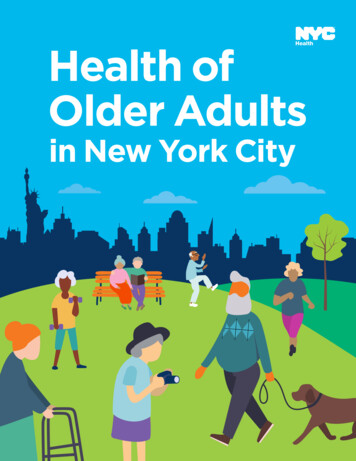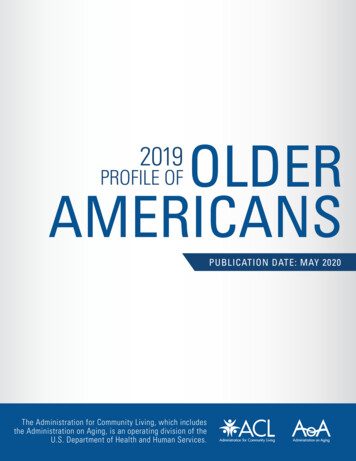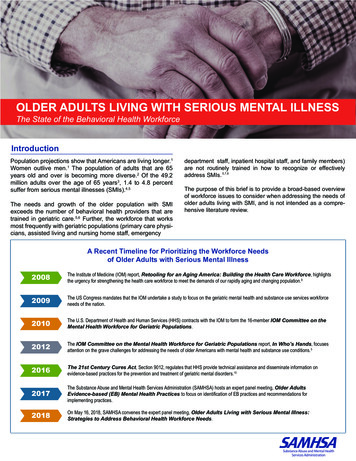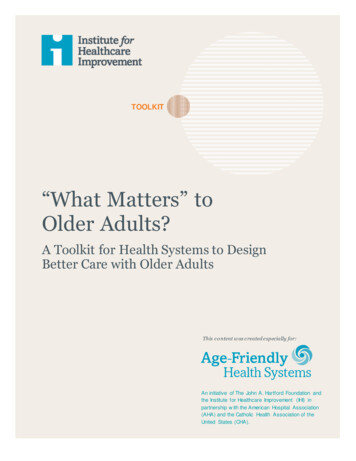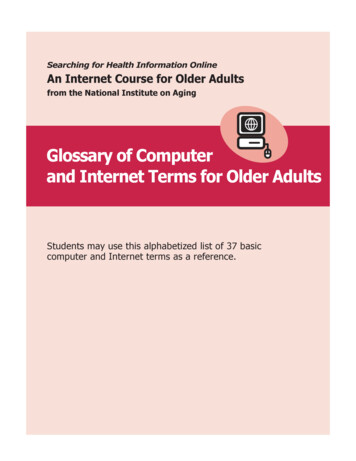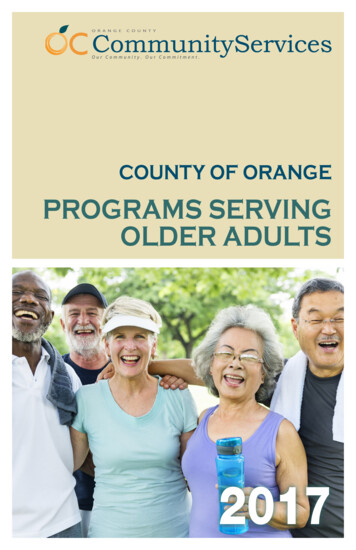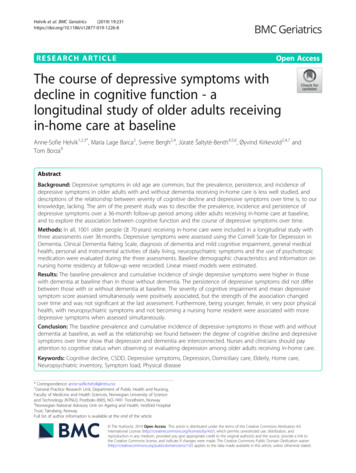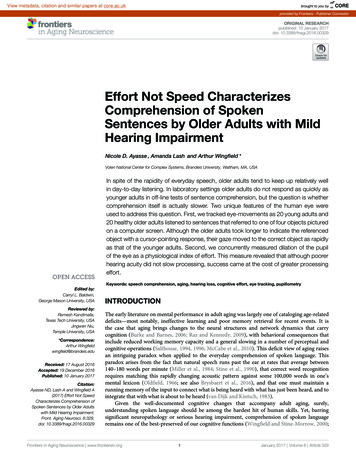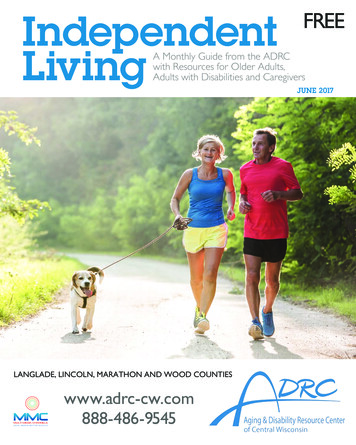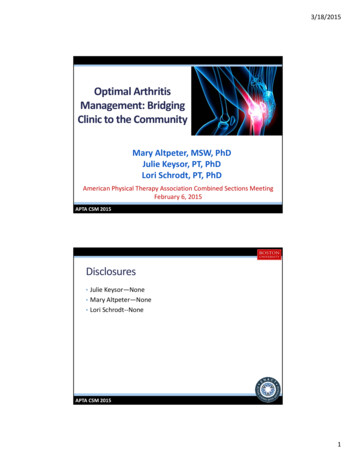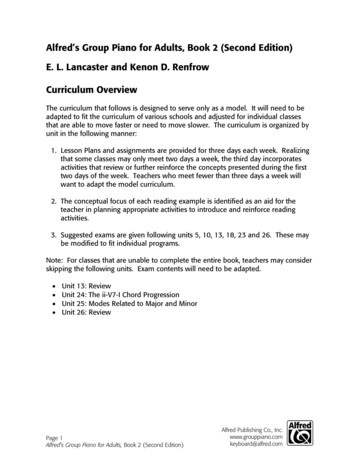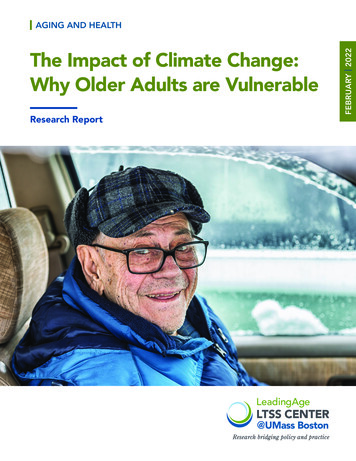
Transcription
The Impact of Climate Change:Why Older Adults are VulnerableResearch ReportFEBRUARY 2022AGING AND HEALTH
About this ReportThe LeadingAge LTSS Center @UMass Boston would like to thank the University of MassachusettsBoston (UMass Boston) McCormack Graduate School of Policy and Global Studies and the UMassBoston Sustainable Solutions Lab for supporting the work of Caitlin Connelly on this project.Authors:Natasha Bryant, Senior Director of Workforce Research and Development, LeadingAge LTSSCenter @UMass BostonRobyn Stone, Senior Vice President of Research, LeadingAge and Co-Director,LeadingAge LTSS Center @UMass BostonCaitlin Connelly, Gerontology PhD Student, Department of Gerontology, McCormack GraduateSchool of Policy and Global Studies, University of Massachusetts BostonKathrin Boerner, Professor and Graduate Program Director, Department of Gerontology,McCormack Graduate School of Policy and Global Studies, University of Massachusetts BostonAbout the LTSS CenterThe LeadingAge LTSS Center @UMass Boston conducts research to help our nation address thechallenges and seize the opportunities associated with a growing older population. LeadingAgeand the University of Massachusetts Boston established the LTSS Center in 2017. We strive toconduct studies and evaluations that will serve as a foundation for government and provideraction to improve quality of care and quality of life for the most vulnerable older Americans.The LTSS Center maintains offices in Washington, DC and Boston, MA.For more information, visit LTSSCenter.org.The Impact of Climate Change: Why Older Adults are Vulnerable
Table of ContentsIntroduction.1Why are Older Adults Vulnerable to Climate Change?.2The Disproportionate Impact of Climate Change on Older Adults.4Emergency Preparedness and Response .6Assisting Older Adults .7Issues for Future Study and Discernment.11Conclusion.12References.13
IntroductionThe term “climate change” refers to a prolonged shift in theaverage weather pattern that can define Earth’s local, regional,and global climates (NASA, n.d.). The key indicators of climatechange are varied and can include: Increased land and ocean temperatures around the globe. Rising sea levels. Ice loss at Earth’s poles and in mountain glaciers. Extreme weather events, including hurricanes,heatwaves, wildfires, droughts, and floods (NASA, n.d.).In addition to impacting the environment, climate change also has the potential to affect humanhealth, cause disruptions in the lives of individuals, and damage some sectors of the U.S. economy.People who are aged 65 and older are particularly vulnerable to the effects of climate change.Advancing age and the prevalence of special needs increases the vulnerability of these individuals toclimate stressors and risks. Older adults who have chronic illnesses, live with functional impairments,or receive long-term services and supports (LTSS) are at high risk for negative health outcomes fromclimate change and may experience disruptions in critical services both during a climate event andover the long-term (Gamble et al., 2013; Filberto et al., 2009-2010; Schols, DeGroot, and Van DerCammen, 2009; Begum and Johnson, 2010).Despite their vulnerability, older adults are often left out of climate change discussions. Local andstate public health departments, first responders, LTSS and other health care providers, and society ingeneral tend to overlook older adults until after an extreme weather event or disaster has occurred.Few efforts and initiatives have focused on studying the long-term consequences of these events forthe older population, preparing at-risk older adults and their families for such events, or helping olderadults and their families better understand, prevent, and mitigate the long-term, chronic effects ofclimate change on this population.Scientific and demographic projections suggest that this approach must change.Climate change is projected to impact our planet at least through the end of this century, while theolder population, which is most vulnerable to the effects of climate change, is projected to increaseexponentially over the next 40 years. Consider these demographic data: In 2020, 56 million Americans were aged 65 and older, and represented 16% of the U.S.population. Adults aged 85 and older numbered 6.7 million. By 2060, the number of older Americans will nearly double to 95 million and older adults willmake up 23% of the U.S. population. Significantly, the 85-and-older population is expectedto triple to 19 million. Older Americans will also become more ethnically and racially diverse,with the percentage of older adults of color increasing from 23% to 45% between 2016 and2060 (Mather, Scommegna, and Kilduff, 2019).The Impact of Climate Change: Why Older Adults are Vulnerable1
Aims of This ReportThis research report demonstrates why older adults are at greater risk for the consequences ofclimate change. The report highlights the disproportionately negative outcomes of climate changeon older adults receiving long-term services and supports, and recommends actions that variousstakeholders can take to address the short- and long-term effects of climate change on thisvulnerable population.Why are Older Adults Vulnerable to Climate Change?Several physiological and psychological factors contribute to the vulnerability of older adults toclimate change.Aging ProcessIncreasing age is a risk factor for limited mobility and physical functioning, multiple chronic conditions,susceptibility to dehydration, and diminished sensory awareness (ACL, 2018a; Benson and Aldrich,2007). These physical conditions may reduce the ability of older adults to respond to climatestressors, communicate their needs to emergency response teams, and detect an emergency.Chronic illnesses can worsen when a climate change-related event or crisis causes an older personto experience: Lack of food and water. Extreme heat or cold. Stress. Exposure to infection. Interruptions in medication regimens.In addition, individuals with limited mobility who rely on support and/or durable medical equipmentmay have disruptions in assistance during a climate change-related event (Balbus et al., 2016;Gamble et al., 2013; Filberto et al., 2009; ACL, 2018b; Benson and Aldrich, 2007).Cognitive ImpairmentCurrently, 5.8 million Americans live with Alzheimer’s disease, the most common form of dementia.That number is expected to increase to nearly 14 million by 2050. The risk of developing Alzheimer’sdisease increases with age. While 3% of older adults between the ages of 65 and 74 are living withAlzheimer’s, 32% of individuals 85 and older are living with the condition (Alzheimer’s Association, 2020).During a climate change-related event, people with cognitive impairments may have limitedunderstanding of communications about risk, weather warnings, disaster orders, and offers ofassistance. They may also have difficulty taking preventive measures before the event or respondingappropriately after the event to protect themselves. These individuals also may become agitatedduring a crisis. A study of evacuations during Hurricane Gustav in 2008 found that nursing homeresidents with severe dementia had increased mortality risk 30 and 90 days after the evacuation(Brown et al., 2012).The Impact of Climate Change: Why Older Adults are Vulnerable2
Social IsolationNearly one-quarter of Americans aged 65 and older wholive in the community are socially isolated (The NationalAcademies of Sciences, Engineering, and Medicine, 2020).Social isolation can reduce an older person’s capacity to copewith climate-related stresses. Frail and housebound olderindividuals are less able or less willing to flee from potentialharm during an emergency. Socially isolated older people maynot receive emergency information or ask for help. Rescuersmay not be aware of these individuals during their rescue andrecovery efforts (Banks, 2013).Socioeconomic StatusAn older person’s ability to prepare, adapt, and respond to climate-related events is determinedby their ability to pay for the implementation of those activities (Filberto et al., 2009). Povertytends to increase as older adults age, with people aged 80 and older experiencing a higher povertyrate (11.6%) than those aged 65 to 79 (7.9% to 9.3%) (Zhe and Dalaker, 2019). Older adults livingon fixed incomes or living at or near poverty may experience greater exposure to the effects ofwarmer summers and colder winters because they do not have air conditioning or are reluctant todeplete their limited financial resources by using air conditioners or heaters.The effects of extreme events are likely to have a greater impact on older Americans who live insubstandard housing (Gamble et al., 2013). These older adults may postpone necessary repairs andaccessibility modifications to their homes, making it difficult for those homes to withstand significantweather events and for older occupants to evacuate their homes in a timely and safe manner.Geographic LocationOlder adults in general, and higher concentrations of older adults with low incomes, live in high-risklocations that may be more affected by global warming (Gamble et al., 2013). These locationsinclude: Coastal zones: Coastal areas have experienced morefrequent and severe tropical storms. For example,20% of older adults lived in a county where a hurricaneor tropical storm was likely to make landfall from 1995through 2005 (Zimmerman, Sloan, and Reed, 2014). Large metropolitan areas: Urban locations areconsidered a risk factor for vulnerability to climatestressors because of the “urban heat island effect,”which occurs when dense concentrations of pavement,buildings, and other surfaces absorb and retain heat,leading to heat-related illness and mortality(Gamble et al., 2013).The Impact of Climate Change: Why Older Adults are VulnerableNearly one-quarterof Americans aged65 and older wholive in the communityare socially isolated.3
Racial and Ethnic DisparitiesRacial and ethnic disparities can make older Americans more susceptible to the effects of climatechange because members of minority groups are more likely to experience the conditions thatincrease climate change-related risks. That is, these older adults are more likely to live in poverty,and to have a poorer health status, limited access to health care, and poorer housing conditions(Gamble et al, 2013).The Disproportionate Impact ofClimate Change on Older AdultsResearchers have examined how several aspects of climatechange—including extreme heat or cold, poor air quality, andextreme weather disasters—affect the health of older Americans.For example, heat waves, hurricanes, and flooding are allassociated with higher risk of hospitalization and higher mortalityrates for people 65 and older, compared to people under the ageof 65. In addition, older adults may be at increased risk for: The psychological health effects of weather events. Negative physical and mental health outcomes resulting from air pollution, wildfires, and droughts. Disruption of services due to forced evacuations. These interruptions can worsen preexistingconditions for people with chronic illness.Heat WavesOlder adults are at increased risk of hospitalization and death due to heat waves. For example: The risk of hospitalization for older adults in Massachusetts was shown to increase duringheatwaves (Liss et al., 2017). Nearly 80% of the excess deaths following the 2003 Paris heat wave were among peopleaged 75 and older. (“Excess deaths” represent the difference between the observed numbersof deaths in specific time periods and expected numbers of deaths in the same time periods.) 72% of deaths associated with the July 1995 heat wave in Chicago were among people65 and older. Higher summer temperatures were associated with increased mortality rates among older adultsin the southeastern United States (Fouillet et al., 2006; Shi et al., 2016; Whitman et al, 1997). Mortality rates associated with heat waves increase for adults 75 to 84 and even more for adultsover the age of 84 (Berko and Ingram, 2014).Air QualityAir pollution is associated with increased risk of negative health effects for older adults compared toyounger adults. It is also associated with a higher incidence of dementia (Sacks et al., 2011; Chen et al.,2017).The Impact of Climate Change: Why Older Adults are Vulnerable4
Extreme Weather EventsOlder adults are vulnerable to the dangers of hurricanes.For example: Adults residing in nursing homes during a hurricane hada 2.6% higher risk of 90-day mortality compared tonon-hurricane periods (Dosa et al., 2010; Dosa et al.,2012). Three weeks following Hurricane Sandy in 2008 there wasa significant increase in emergency department visits byolder adults, with rates highest among those aged 85and older (Malik et al., 2018). Almost three-quarters of deaths from Hurricane Katrina in 2005 and over half of deaths fromHurricane Sandy occurred among older Americans (United States. Executive Office of thePresident, Assistant to the President for Homeland Security, and Counterterrorism, 2006). People 65 and older had the greatest mortality risk compared to other age groups followingHurricane Maria, which hit in Puerto Rico in 2017 (Cruz-Cano and Mead, 2019; Santos-Burgoaet al., 2018).EvacuationsEvacuation and relocation of older adults during disasters may be detrimental to their health andwell-being. For example: More than 200,000 people with chronic illness were displaced or isolated due to flooding duringHurricane Katrina and were unable to access medical care and take medications (United States.Executive Office of the President. Assistant to the President for Homeland Security, &Counterterrorism, 2006). Nursing home residents who relocated following Hurricane Katrina were more likely to developpressure ulcers than non-evacuated residents. Relocated nursing home residents also had a highmortality rate (Castle and Engberg, 2011; Thomas et al., 2012). Nursing home residents with severe cognitive impairment who were evacuated during HurricaneGustav were at increased risk of death 30 and 90 days post-move (Brown et al., 2012).Psychological EffectsStudies suggest that older adults may experience increasedrates of depression, anxiety, and post-traumatic stress disorderduring and immediately following natural disasters (Leyva,Beaman, and Davidson, 2017). A meta-analysis of studies onthe psychological effects of natural disasters found that, whencompared with younger adults, older adults were: 2.11 times more likely to develop post-traumaticstress disorder.Adults residing innursing homes duringa hurricane had a 2.6%higher risk of 90-daymortality compared tonon-hurricane periods. 1.73 times more likely to develop adjustment disorder.There were no significant differences between younger and older adults regarding the likelihood ofdeveloping depressive symptoms following natural disasters (Parker et al., 2016).The Impact of Climate Change: Why Older Adults are Vulnerable5
The psychological effects of living through a hurricane may be long lasting for older adults. Adeola andPicou (2014) found that older adults had higher stress levels three years after Hurricane Katrina, relativeto individuals under the age of 65. While most nursing homes provide mental health services duringnormal operations, these services are often interrupted and not prioritized during disasters (Brown, 2007;Levinson, 2012).Emergency Preparedness and ResponseThe majority of older adults are minimally prepared for disasters,do not have an emergency plan, are not aware of relevant resources,and do not participate in disaster preparedness educational programs(Wang, 2018; Kim and Zakour, 2017; Al-Rousan, Rubenstein, andWallace, 2015; Bell et al., 2019a; Kloseck et al., 2014). Whenpreparations do occur, they are more limited and primarily focusedon stocking supplies like food and water that are needed for survival.Older adults are less likely to have planning and structuralpreparedness (Wang, 2018).These findings are particularly concerning, given the fact that climate change-related disasters andextreme weather events disproportionately affect the older population.A 2019 University of Michigan National Poll on Healthy Aging found that 50-to 80-year-old adults hadnot taken steps recommended by disaster preparedness agencies (Bell et al., 2019a). Less than half: Signed up to receive local emergency alerts. Talked with family or friends about an evacuation plan. Stocked an emergency kit. Had a generator.In addition, more than half of poll respondents said they: Would find it difficult to afford to stay somewhereelse for a week. Were somewhat or not confident that they wereprepared to take care of themselves or a familymember if a power outage lasted more than a day.The majority of older adultsare minimally prepared fordisasters, do not have anemergency plan, are notaware of relevant resources,and do not participate indisaster preparednesseducational programs. Were not prepared for an evacuation of the home orfor a severe weather event.The poll did find that most older adults had prepared for a severe weather event by collecting theirbasic supplies. More than half had a seven-day supply of food and water on hand. Among thosewho required essential medications and health supplies, 82% had a seven-day supply of essentialmedications and 72% had enough health supplies to last seven days.The Impact of Climate Change: Why Older Adults are Vulnerable6
Assisting Older AdultsOlder adults and informal caregivers can take steps to prepare themselves, family members, orfriends for emergency situations. Agencies and professionals serving older adults also can play a rolein preparing and helping older adults and informal caregivers respond to and recover from thedisaster. These agencies and professionals can: Help older adults and informal caregivers properly plan and prepare prior to the event. Provide older adults and informal caregivers with outreach and education. Involve appropriate agencies in the emergency planning process. Support and relocate older adults after a disaster. Engage professionals who can help older adults and their informal caregivers prepare foremergency situations.Preparation and EducationThe Centers for Disease Control and Prevention (CDC), theFederal Emergency Management Agency (FEMA), Administrationon Aging, and other agencies have developed guidelines andtoolkits to help older adults prepare for and respond to a disaster(CDC, 2018; FEMA, 2015; Administration on Aging, 2006).The guidelines and toolkits encourage older adults to createan individualized plan that identifies: How they will respond to a disaster. A contact person and method for communicating withthe contact. How they will leave their home, if necessary, and where they will go during an emergency. Contingency plans that do not rely on informal caregivers, in case caregivers are unable tohelp the person adequately. Updated medication lists (CDC, 2018; Al-Rousan et al., 2015; Banks, 2013; FEMA, 2015;Administration on Aging, 2006).Older adults can develop their individualized plan with help from staff at the local area agency onaging and health or social service professionals who assist older adults. Planning can be coordinatedwith local emergency management personnel, including the local office of emergency management,the fire department, and the public health department.Many older adults lack awareness and knowledge about the heightened risk that climate change-relatedevents pose for them or how to prepare for and respond to these events. Public health, emergencymanagement, and other officials can improve their communication with older adults by: Providing information in multiple formats, such as audible and visual cues and writtenmaterials in large type or Braille. These formats can accommodate individuals who havesensory or cognitive disabilities.The Impact of Climate Change: Why Older Adults are Vulnerable7
Making resources available in places where older adults are more likely to access them. Involving community helpers, peer educators, and trained community-based workers—includinghome care aides and community health workers—in providing information and education.Because older adults have relationships with these workers, they may be more willing to acceptinformation from them about how to meet practical needs following a disaster (Elmore andBrown, 2007; Wang, 2018; AARP, 2006; Bell et al., 2019b).Role of Agencies, Community Leaders, and ProvidersPublic health departments conduct disaster-related preparedness programs, but these programs aren’tnecessarily designed to address the needs and challenges of older adults (CDC, 2018). Studies suggestthat these departments, and other government agencies, could help mitigate the negative impact ofdisasters on older adults if there was a higher level of coordination between them and providers of agingservices (Pierce et al., 2017).The emergency planning process at the state or local levelshould involve older adults, providers, and informal caregivers.It should also feature collaboration among multiple agencies,such as Medicaid; the departments of aging, transportation,housing, and public health; and providers of medical care,long-term services and supports, and other social services.Area agencies on aging can be instrumental in disaster planningbecause they can access a wide variety of available resources atthe local level (AARP, 2006).The emergencyplanning process atthe state or local levelshould involve olderadults, providers, andinformal caregivers.All stakeholders can help identify and meet the specific needs of vulnerable older adults during eachphase of an emergency. They can work together to create emergency assessment protocols, guidelines,and checklists that include the specific needs and priorities of older persons who are affected by theevents (World Health Organization, 2008). These stakeholders should work with disaster managementteams at the federal, state, and local levels (Al-Rousan et al., 2015; Kloseck et al., 2014; Banks, 2013) soprotocols specific to older adults can be integrated into disaster preparedness plans at all levels.Policymakers and human service professionals can collaborate with and train community leaders inemergency response so they can disseminate information to generate awareness, and effectively prepareand build the capacity of older adults and informal caregivers (Kim and Zakour, 2017). These communityleaders can include: Community organizers. Local council members or other government leaders. Volunteer or faith leaders. Nonprofit leaders. Resident councils at nursing homes and affordable housing communities.The Impact of Climate Change: Why Older Adults are Vulnerable8
Communities with low social capital may lack the necessaryresources to respond adequately during a disaster. The followingstrategies may help: Ask nonprofit and community-based organizations toidentify and reach out to older adults. These organizationsmay be the only stakeholders in the community that canfulfill this task. Ask older adults to identify vulnerable peers who mayneed help from emergency services personnel. Olderadults can also convey important information to theirnetworks of friends and acquaintances. Encourage family caregivers to enroll their care recipients in a location-tracking program beforea disaster. These programs use GPS transmitters linked to emergency personnel to locateindividuals who are lost or unable to explain where they live.Frontline Professionals Serving Older AdultsFrontline professionals—including case managers, social workers, nurses, primary care physicians, andgerontologists—can help older adults prepare for an emergency and respond and recover after thedisaster (Gallo et al., 2018; Kusmaul, Gibson, and Leedahl, 2018). These professionals are in a uniqueposition to understand the characteristics of older adults in the community because they regularly assessthe social isolation, frailty, sensory impairment, mobility, and dementia status of their older clients.Having this assessment information on hand allows frontline professionals to create a profile of the healthand social needs in the community, identify vulnerable persons, and anticipate their needs for healthsupplies like medications, equipment, and assistive aids. This information also can help providers anticipatethe need to train health personnel to assess and treat older persons during an emergency (World HealthOrganization, 2008; Wang, 2018).After a disaster, frontline health professionals can continue toplay a role in assisting older adults. These professionals can: Inform older adults about shelters, evacuations, andthe availability of resources. Address barriers that may keep older adults frommaking decisions. Educate older adults who are new to the communityabout the impacts of displacement and relocation. Conduct assessments for post-traumatic stress disorderand provide evidence-based treatments. Identify resources to address any financial challengesolder adults are facing.Frontline professionals—including case managers,social workers, nurses,primary care physicians,and gerontologists—canhelp older adults preparefor an emergency andrespond and recoverafter the disaster. Work with interprofessional teams to determine if the disaster has caused service limitationsor other negative impacts for older adults in the community. Build community resilience through age-friendly community planning, and provide guidelinesaddressing the needs of older community residents (Kusmaul, Gibson, and Leedahl, 2018).The Impact of Climate Change: Why Older Adults are Vulnerable9
ProvidersThe Emergency Preparedness Rule issued by the Centers for Medicare & Medicaid Services (CMS) requiresthat, as of November 2016, all 17 CMS provider/supplier types, including LTSS providers and home healthcare agencies, have their own emergency preparedness regulations that cover four core areas:1. Risk assessment and emergency planning.2. Communication plan.3. Policies and procedures.4. Annual training and testing (CMS, 2016).A LeadingAge toolkit walks providers of aging services through the core elements outlined in the CMSEmergency Rule. The toolkit defines the four elements and provides templates, tools, best practices, andadditional resources (LeadingAge, n.d.). The American Health Care Association (AHCA) and the NationalCenter for Assisted Living (NCAL) also have compiled online emergency preparedness resources that aredesigned for an expanded audience of providers offering services not covered by CMS programs,including assisted living communities (AHCA and NCAL, n.d.).Studies suggest that disaster preparedness in LTSSorganizations improves with regular staff training and reviewof organizational plans (Levinson, 2012; Pierce et al., 2017).The CMS Emergency Preparedness Rule requires that nursinghomes and home health care agencies have initial and annualtraining on emergency plans and preparedness (CMS, 2016).Providers also should train staff on mental health servicesavailable during and immediately following a disaster.Relocation plans shouldensure that older adultshave the appropriatesupports and resourcesthey need to addressany medical andcognitive issues.While not specifically addressed in the CMS Emergency Preparedness Rule, providers that are notrequired to comply with CMS regulations would likely benefit from emergency preparedness trainingand should incorporate this training into their disaster plans.Evacuation and RelocationMany locales lack specific evacuation plans for older persons living in the community and in nursinghomes. This is a major problem throughout the country.Evacuation and relocation plans should make it clear how to transport older persons and persons withdisabilities safely. Plans should also identify accessible shelters that are appropriately equipped andstaffed to meet essential needs. Recommendations for assistingolder adults during evacuation and relocation are included in a2006 AARP toolkit.The quality of a post-disaster relocation can influence how olderadults adjust to the relocation. Relocation plans should ensurethat older adults have the appropriate supports and resourcesthey need to address medical and cognitive issues. Older adultsshould be relocated to areas where informal support networkscan provide care and where older adults can reestablish contactwith physical and mental health providers to address any needs(Maxwell and Fitzgerald, 2011; Elmore and Brown, 2007).The Impact of Climate Change: Why Older Adults are Vulnerable10
Special Needs Shelters are operated separately from general shelters and can accommodate and care forpeople with severe medical needs during a disaster (Benson and Aldrich, 2007). However, these sheltersare not always designed for nursing home residents and are not always staffed by medical professionalswho have experience working with older adults.Issues for Future Study and DiscernmentAs we look to the future, several issues
The LeadingAge LTSS Center @UMass Boston conducts research to help our nation address the challenges and seize the opportunities associated with a growing older population. LeadingAge . Professor and Graduate Program Director, Department of Gerontology, McCormack Graduate School of Policy and Global Studies, University of Massachusetts Boston
